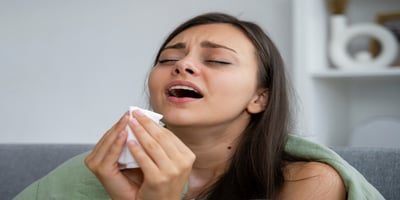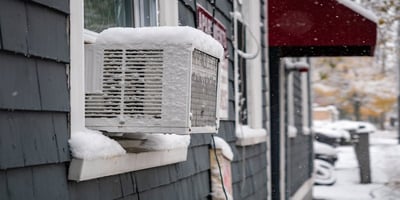How to Clean Mold Out of an Air Conditioner? Effective Methods
Key Takeaways
- Mold grows in your AC because of trapped moisture, clogged filters, and poor drainage—fix these three things and you'll prevent most problems.
- Spot the warning signs early: musty smells when you turn on the unit, visible dark spots around vents, or suddenly worse allergies indoors.
- Vinegar or hydrogen peroxide work better than bleach for ac mold cleaning without damaging your unit's metal parts.
- Change filters regularly and keep indoor humidity moderate to stop mold before it starts.
- Call a professional if mold covers large areas, keeps returning, or spreads into your ductwork.
That musty smell hitting you when your AC kicks on? It's mold, and it's more than just unpleasant. When you're learning how to clean mold out of an air conditioner, you're protecting both your wallet and your lungs. Your AC creates the perfect mold paradise—dark, damp, and full of dust—which means regular cleaning isn't optional. Let's walk through exactly how to tackle this problem and keep it from coming back.
The causes of mold in your AC system follow predictable patterns, which means you can stop problems before they start.
Trapped moisture does the heavy lifting. Every time your AC cools air, condensation forms on the coils. Clogged drain lines or tilted drain pans create standing water pools where mold spores land and multiply quickly.
Your filters become mold hotels when dirty. A clogged filter traps humidity and collects organic debris like dust, pollen, and pet dander. Combine moisture with food sources, and you've rolled out the welcome mat for mold colonies.
High humidity feeds the cycle. When indoor humidity climbs too high, your AC works overtime and can't keep up. Internal components stay damp longer, and mold thrives. Basements and poorly ventilated bathrooms make the problem worse.
Skipped maintenance accelerates everything. Miss a few filter changes, ignore drain line clogs, forget annual cleaning—each neglected task compounds until you spot visible growth.
Recognizing the Signs of Mold in Your Air Conditioner
Catch these signs of mold early and you'll save yourself from a major cleaning project.
Your nose knows first. That distinctive musty, earthy smell when your AC runs? Mold releases volatile organic compounds as it grows. The smell might fade after the unit runs awhile, but the problem stays.
Visual clues appear around vents and drain pans. Look for fuzzy black, green, or white patches on vent covers, around the unit's housing, or near the drain pan. Even small visible spots signal larger colonies hiding inside.
Your allergies get worse indoors. Sneezing more at home but fine outside? Watery eyes, scratchy throat, and coughing when the AC runs point to airborne mold spores circulating through your rooms.
Energy bills climb without explanation. Mold blocks airflow, forcing your AC to run longer cycles. Rooms take longer to cool and the unit runs constantly without reaching your set temperature.
Want to confirm your suspicions? Learn how to test indoor air quality for moldusing DIY test kits or professional services. Modern air quality monitors track volatile organic compounds and humidity in real-time, alerting you to mold-friendly conditions before you spot visible growth.
.png?width=800&height=400&name=image_2024-07-11_20-10-24%20(1).png) Getting Ready to Clean
Getting Ready to Clean
Safety matters more than speed when you're dealing with mold spores.
Safety First
Cut the power completely. Flip the breaker for your AC unit—don't just use the thermostat. For window units, unplug them. You're working with water and electrical components, which makes this step non-negotiable.
Gear up properly. Grab a respirator mask designed for mold spores, rubber gloves that extend past your wrists, and safety goggles. Mold spores become airborne during cleaning, and you don't want to breathe them or get cleaning solution in your eyes.
Create airflow through the space. Open windows and point a fan outward to push spore-filled air outside rather than circulating it through your home.
Gather Your Supplies
You'll need:
- Respirator mask, rubber gloves, safety goggles
- Soft-bristled brush and microfiber cloths
- HEPA vacuum (regular vacuums just blow spores around)
- White vinegar or hydrogen peroxide
- Spray bottles
- Bucket for rinsing
- Screwdriver for panel removal
Skip the bleach—it corrodes metal coils and creates toxic fumes in enclosed spaces. Vinegar and hydrogen peroxide kill mold effectively without the damage.
.png?width=800&height=400&name=image_2024-07-11_20-11-38%20(1).png)
How to Clean Mold Out of an Air Conditioner
Follow these steps methodically. Rushing leads to missed spots where mold returns.
Step 1: Tackle the Filters First
Pull out your filters according to your unit's manual. If you spot holes or heavy mold penetration, replace them. For washable filters:
- Vacuum both sides with your HEPA attachment
- Fill a basin with equal parts vinegar and warm water
- Submerge filters completely and let them soak
- Scrub gently with your soft brush
- Rinse until water runs clear
- Air dry completely before reinstalling
Step 2: Clean the Evaporator Coils
The coils behind your filter collect condensation constantly, making them mold magnets.
- Remove panels blocking coil access
- Vacuum gently without bending fins
- Spray coils thoroughly with your ac mold cleaner
- Wait for the solution to break down the mold
- Scrub carefully with your soft brush between fins
- Wipe with a damp cloth or lightly rinse
- Let dry completely
Those thin metal fins bend easily, restricting airflow and reducing efficiency.
Step 3: Clean the Drain Pan and Line
This is where standing water breeds the worst mold growth.
- Locate the drain pan under the coils
- Vacuum or sponge out standing water
- Scrub the entire pan with hydrogen peroxide
- Pour a cup of vinegar down the drain line slowly
- Let it sit to kill growth and dissolve clogs
- Flush with clean water
- Dry everything thoroughly
Do this monthly as prevention—it takes minutes and stops most mold problems.
Step 4: Clean the Blower Fan
Mold on fan blades spreads spores throughout your home every time the unit runs.
- Access the fan (check your manual for specific steps)
- Wipe each blade individually with vinegar-dampened cloth
- Clean the fan housing and motor housing exterior
- Let everything dry
Step 5: Finish and Reassemble
Wipe down the exterior casing, clean vent covers, and make sure every single component is bone-dry. Moisture trapped in reassembly restarts the mold cycle immediately. Reinstall parts in reverse order, restore power, and run the unit to confirm normal operation.
.png?width=800&height=400&name=image_2024-07-11_20-10-56%20(1).png)
Prevention of Future Mold Growth
Stopping mold before it starts beats cleaning it repeatedly. Here's what works:
- Maintain Your Filters Religiously: Set phone reminders for regular filter changes. A filter changed on schedule prevents expensive mold cleaning bills down the road.
- Control Your Home's Humidity: Keep indoor humidity moderate using dehumidifiers in naturally damp spaces like basements. High humidity encourages mold growth everywhere—not just in your AC.
- Schedule Professional Maintenance: HVAC techs catch problems you'll miss. Learn how often to service your air conditioner for optimal timing. Annual service before cooling season prevents most issues and addresses drain problems before they cause mold.
- Monthly Drain Line Flushing: Pour a cup of vinegar down your condensate drain line every month. Mark it on your calendar. This simple habit prevents most drain-related mold growth.
- Run the Fan After Cooling: After turning off cooling mode, run just the fan for a while. This dries internal components instead of leaving them damp overnight.
- Keep Your System Clean: Make sure furniture or curtains don't block vents. Vacuum around floor vents and window units weekly. For outdoor condensers, trim vegetation back and remove leaves or debris. Address any water leaks immediately—they feed mold growth and can damage your home.
.png?width=800&height=400&name=image_2024-07-11_20-11-19%20(1).png)
When to Call a Professional
Some mold problems exceed DIY solutions. Contact an HVAC professional when:
- Mold covers most of your AC's interior surfaces and needs specialized antimicrobial treatments
- You've cleaned thoroughly but smell returns within weeks, signaling underlying problems
- Your central air system has moldy ductwork requiring cameras and specialized equipment
- Family members develop respiratory symptoms that may indicate mycotoxin exposure
- You discover mold in inaccessible areas that require specialized tools to reach
Your Best Defense Against AC Mold
Once you master how to clean mold out of an air conditioner, you'll realize the real skill is never needing that knowledge again. Those monthly filter swaps and quick vinegar pours take minutes but buy you years of clean air and lower energy bills. Your AC will thank you, your wallet will thank you, and your lungs will definitely thank you—all because you chose prevention over procrastination.
FAQ
How often should I clean mold from my air conditioner?
You shouldn't see visible mold with proper maintenance. Inspect monthly, clean immediately if you spot signs of mold, replace filters regularly, and deep-clean annually before cooling season starts.
What's the best ac mold cleaner that won't damage my unit?
White vinegar or hydrogen peroxide work safely on all AC components. Skip bleach—it corrodes metal coils and creates toxic fumes. Commercial HVAC cleaners labeled "no-rinse coil cleaner" also work well.
Can mold in my AC actually make my family sick?
Absolutely. Mold exposure causes respiratory irritation, worsens asthma, triggers allergies, and causes persistent coughing. People with weakened immune systems face more serious risks. Clean immediately if anyone shows symptoms that improve when away from home.
Why does musty smell hit strongest when I first turn on my AC?
Mold growing on coils or in the drain pan releases concentrated spores when the fan starts. The smell might fade as the unit runs, but that doesn't mean the mold disappeared—it just dispersed the spores throughout your home.
What humidity level actually prevents mold growth?
Keep humidity moderate—not too high, not too low. Use a hygrometer to monitor levels. Your AC helps control humidity, but you might need a dehumidifier in naturally humid climates.
Should I attempt this myself or hire a professional?
Clean yourself for routine maintenance, accessible components, and light mold growth. Hire professionals for extensive contamination, recurring problems despite cleaning, central systems with ductwork, or if you have respiratory conditions making mold exposure risky.


































.png)



